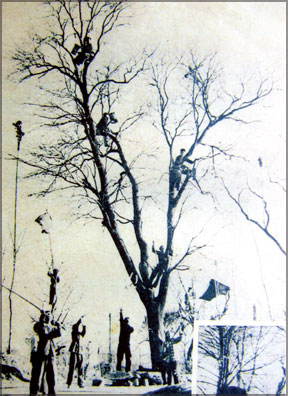China protects its crops
At 5 o'clock on the morning of April 18, 1958, the few western
expatriates in Peking (Beijing) were jerked out of their beds by a
frightful din: shouts, explosions, harshly - shouted orders, al mingled
together. What on earth was afoot? A revolution! A riot, perhaps!
No-nothing of the sort. It was a sparrow hunt.
In Peking, in three days and nights, some 750,000 sparrows perished.
How many more died throughout the country during the macabre hunt when
the whole country was mobilized for it? Many millions, without doubt!
However, after the 72-hour long mass slaughter came to an end, the
government declared that it was a complete success and one of the four
scourges of China had been eliminated by the people.
|

“Operation Sparrow” |
According to posters displayed all over Peking, the four scourges
were the rat, breeder of diseases; the mosquito, bringer of Malaria, the
housefly, responsible for many a sickness, and the sparrow.
What was the sparrow accused of? Being extremely numerous, living
entirely on grain, and contrary to the old belief of being a voracious
feeder. In accordance with government publications and the Chinese media
a single sparrow eats 5 1/2 pounds of corn a year, thus a million of
them consumed each year 2,500 tons of seed corn. For a country with a
high rate of population growth and having to feed more hungry mouths
year by year, the sparrow was a pest to be disposed of, at any cost.
But, how were they to be destroyed? Shooting was impracticable as
gunpowder was expensive, even though gunpowder was supposed to have been
invented in China. In the mean time, a Russian scientist announced that
sparrows could not fly for 2 to 3 hours nonstop, before they fall
exhausted to the ground. The Chinese authorities decided to put this
theory into practice.
At length a major propaganda campaign was launched, aimed at
mobilizing the entire population for the battle. Orders were soon issued
making it imperative for everyone to participate, irrespective of sex,
age or physical standing.
On the anticipated day (April 18) and hour (5 a.m.)
"Operation-Sparrow" took off the ground. From the small hours noisy
crowds swarmed the streets of Peking. Submitting to orders of the
government or those in command of streets and housing schemes, or the
stern calls of street loudspeakers and the radio, the whole population
of Peking left their houses.
The milling crowds if men, women and children banged at metal pans,
set off fire-crackers, raised old broom handles or sticks with rags
tight to them at the flocks of birds flying above, all the while
shouting at the top of their voice (certainly, the Chinese are past
masters at this) Enthusiastic young men climbed on to roof tops or
nearby trees, while the others remained in the streets or squares, home
gardens and the open places, keeping up the halloo in unison. There
common endeavor was to prevent the sparrows from alighting on roofs and
the branches of trees.
The students of schools tried to bring down the birds on the wing
with slings and catapults, which had been distributed to them by the
teaching staff. The members of the Diplomatic Missions accredited in
Peking joined the hunt with shotguns in hand from the premises of their
respective embassies.
At the end of 48 hours of excitement and clamor, the exhausted
sparrows began falling to the ground in large numbers. No sooner than
they touched the ground men, women and children rushed up and dispatched
the unfortunate creatures with the sticks and brickbats that were in
readiness in their hands.
This went on for 72 hours during which no resident of Peking had a
wink of sleep, including those physically unfit. If the sparrows fell
from exhaustion their hunters too were on the point of doing so.
Some slipped from roofs or trees, and ended up with broken limbs,,,
but the zeal of the others remained unflagging.
On April 21, orders went out to stop the hunt, and the whole city
became strangely calm and quite, while parades were organized to show
off the trophies of the chase. The final balance sheet of the hunt,
which was conceivable under an authoritative regime showed a credit in
the sense that the sparrows simply disappeared from the Chinese scene.
But was the ultimate aim- a better harvest- achieved?
This is the sort of question to which one can get no answer. And even
if one could, what is it now to the sparrows?
A western journalist domiciled in Peking at the time commented in his
story thus, "It is difficult to know exactly what goes on in China,
because the political propaganda gives quite contradictory accounts.
It is true that it was realized somewhat later that the sparrows also
played a useful role in destroying the insects harmful to crops and so
any mass extermination of them was an error of judgment, besides being a
piece of criminal stupidity." |
